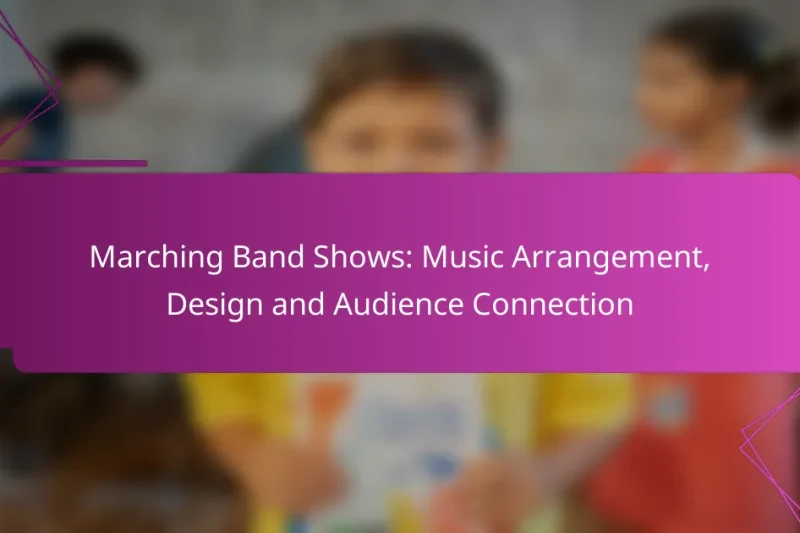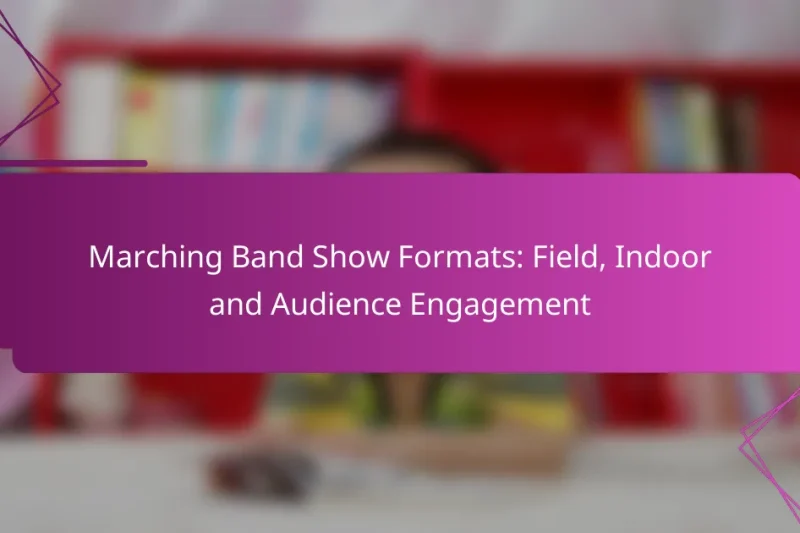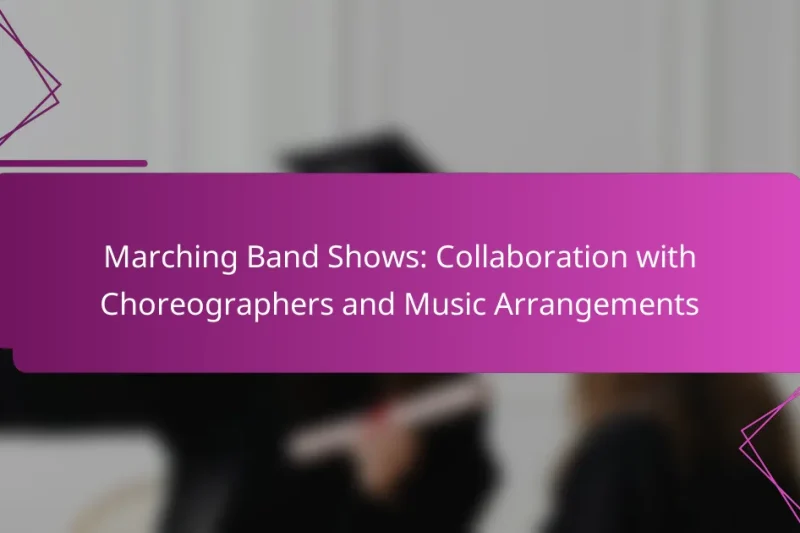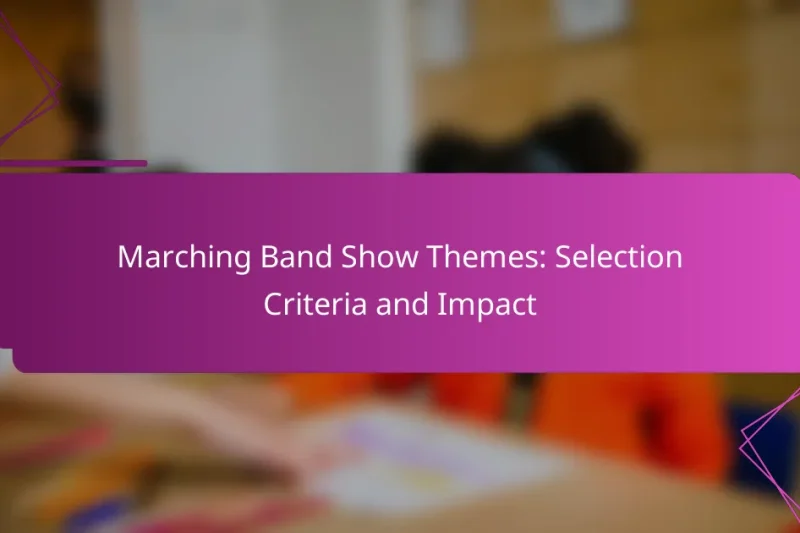Marching band show design plays a crucial role in enhancing audience engagement by integrating captivating elements … Marching Band Show Design: Audience Engagement and Captivating ElementsRead more
Marching Band Show Design Principles
Marching band show design is an intricate blend of visual storytelling, musical cohesion, and audience engagement. By establishing a cohesive theme and employing effective staging and dynamic movement, designers can create performances that resonate deeply with both the audience and the performers. Engaging the audience through interactive elements and emotional connections further enhances the overall experience, ensuring that each show leaves a lasting impression.
Marching Band Shows: Music Arrangement, Design and Audience Connection
Marching band shows in the United States are a dynamic fusion of creativity, thematic unity, and … Marching Band Shows: Music Arrangement, Design and Audience ConnectionRead more
Marching Band Show Formats: Field, Indoor and Audience Engagement
Marching band show formats vary significantly between field and indoor performances, each offering unique opportunities for … Marching Band Show Formats: Field, Indoor and Audience EngagementRead more
Marching Band Shows: Collaboration with Choreographers and Music Arrangements
Marching band shows thrive on the synergy between musicians and choreographers, where open communication and clearly … Marching Band Shows: Collaboration with Choreographers and Music ArrangementsRead more
Marching Band Performances: Visual Effects, Choreography and Audience Impact
Marching band performances are transformed into captivating spectacles through the use of visual effects and innovative … Marching Band Performances: Visual Effects, Choreography and Audience ImpactRead more
Marching Band Show Design: Key Elements, Themes, and Visual Effects
Designing a marching band show requires a thoughtful approach that integrates strong themes, captivating choreography, and … Marching Band Show Design: Key Elements, Themes, and Visual EffectsRead more
Marching Band Show Themes: Selection Criteria and Impact
Choosing an effective marching band show theme is crucial for creating an engaging and memorable performance. … Marching Band Show Themes: Selection Criteria and ImpactRead more
What are the key principles of marching band show design?
The key principles of marching band show design include visual storytelling, musical cohesion, audience engagement, effective staging, and dynamic movement. These elements work together to create a cohesive and impactful performance that resonates with both the audience and the performers.
Visual storytelling
Visual storytelling in marching band involves conveying a narrative through movement, formations, and color. Each show should have a clear theme or story that guides the visual elements, helping the audience connect emotionally. For example, using specific shapes or transitions can symbolize different parts of the story.
To enhance visual storytelling, consider the use of props and costumes that align with the theme. Ensure that the visual elements are not only aesthetically pleasing but also serve to reinforce the narrative being presented.
Musical cohesion
Musical cohesion refers to the seamless integration of musical elements throughout the performance. This includes ensuring that the music aligns with the visual aspects and that transitions between different musical sections are smooth. A well-cohesive show will have a consistent style and mood that supports the overall theme.
When selecting music, choose pieces that complement each other and create a unified sound. Avoid abrupt changes in style or tempo that could disrupt the flow of the performance. Consider using motifs or recurring themes to tie different sections together.
Audience engagement
Engaging the audience is crucial for a successful marching band performance. This can be achieved through dynamic visuals, captivating music, and direct interaction with the audience. A performance that draws in viewers will leave a lasting impression and enhance the overall experience.
Incorporate moments of surprise or excitement, such as unexpected formations or powerful musical crescendos. Additionally, consider the placement of the band on the field to maximize visibility and connection with the audience.
Effective staging
Effective staging involves the strategic arrangement of performers on the field to create visually appealing formations. This includes considering sightlines, spacing, and the overall layout of the performance. Proper staging ensures that the audience can see and appreciate the intricacies of the show.
Utilize the entire performance area to create depth and interest. Regularly rehearse formations to ensure that transitions are smooth and that performers are aware of their positions relative to one another and the audience.
Dynamic movement
Dynamic movement is essential for maintaining energy and interest throughout the performance. This includes not only the marching style but also the use of body movements and gestures that enhance the visual impact. Performers should be encouraged to express themselves through their movements while staying in sync with the music.
Incorporate a variety of movement types, such as quick steps, fluid transitions, and dramatic pauses. This variety will keep the performance lively and engaging, making it more memorable for the audience. Regular practice and feedback will help performers refine their movements and enhance the overall presentation.
How do you create a cohesive theme for a marching band show?
Creating a cohesive theme for a marching band show involves establishing a central concept that guides all aspects of the performance, including music, visuals, and overall presentation. This ensures that every element works together to convey a unified message or story.
Define the central concept
Start by identifying a central concept that resonates with your band and audience. This could be a specific story, emotion, or idea that you want to express through your performance. For example, themes like “A Journey Through Time” or “Nature’s Symphony” can provide a strong foundation.
Once you have a concept, ensure that it is clear and relatable. This clarity will help your musicians and designers align their efforts towards a common goal, making the show more impactful.
Integrate music and visuals
To create a cohesive show, music and visuals must complement each other. Select musical pieces that reflect the mood and narrative of your theme, and design visual elements—such as costumes, props, and choreography—that enhance the musical experience.
For instance, if your theme is “Under the Sea,” consider using flowing blue fabrics and aquatic-themed visuals alongside music that evokes the sound of waves. This integration helps reinforce the theme and keeps the audience engaged.
Use consistent motifs
Incorporate consistent motifs throughout your show to strengthen the theme. This can include repeated musical phrases, visual symbols, or specific colors that appear in various forms. Consistency helps the audience recognize and connect with the theme more deeply.
For example, if your show features a motif of circles to represent unity, use circular formations in your drill, circular props, and even circular patterns in your costumes. This repetition creates a cohesive visual and auditory experience that resonates with viewers.
What are effective strategies for audience engagement in marching band shows?
Effective strategies for audience engagement in marching band shows include incorporating interactive elements, creating emotional connections, and varying the pacing of performances. These techniques help maintain interest and create memorable experiences for spectators.
Interactive elements
Interactive elements can significantly enhance audience engagement by inviting participation. For instance, bands might encourage clapping or singing along during specific sections of a performance. Utilizing technology, such as mobile apps for real-time voting on song selections, can also foster a sense of involvement.
Consider incorporating visual elements like LED screens that display audience reactions or social media feeds. This not only entertains but also connects the audience to the performance, making them feel like part of the show.
Emotional connection
Creating an emotional connection is crucial for engaging the audience. This can be achieved through storytelling within the performance, where the music and visuals convey a narrative. Themes that resonate with universal experiences, such as love, struggle, or triumph, can evoke strong emotional responses.
Using dynamic musical contrasts, such as soft, reflective passages followed by powerful crescendos, can further enhance emotional impact. Engaging with the audience through eye contact and expressive movements also helps to forge a deeper connection.
Varied pacing
Varying the pacing of a marching band show keeps the audience attentive and engaged. A mix of fast-paced, energetic segments with slower, more contemplative moments can create a dynamic flow that captivates spectators. This approach prevents monotony and maintains excitement throughout the performance.
When planning the show, consider the overall arc of the performance. A well-structured sequence that alternates between high-energy and reflective pieces can lead to a more impactful experience. Aim for a balance that allows the audience to absorb the emotional weight of slower sections while still enjoying the thrill of faster tempos.
How can technology enhance marching band show design?
Technology can significantly enhance marching band show design by providing innovative tools for visual and auditory effects. By integrating digital projections, sound amplification, and advanced lighting, bands can create a more immersive and engaging experience for audiences.
Use of digital projections
Digital projections can transform a marching band’s visual presentation by adding dynamic backgrounds and effects that complement the performance. These projections can include animations, thematic imagery, or even live video feeds, which help to tell a story or enhance the overall theme of the show.
When considering digital projections, ensure that the equipment is compatible with outdoor settings, as weather conditions can affect visibility. It’s also important to coordinate the timing of projections with the music and movements of the band to maintain synchronization.
Sound amplification techniques
Sound amplification techniques are crucial for ensuring that the music reaches the audience clearly, especially in large venues. Utilizing microphones, speakers, and mixing equipment can enhance the overall sound quality and volume, allowing for a richer auditory experience.
Consider using wireless microphones for soloists or small groups to avoid clutter on the field. Additionally, balance the sound levels to prevent any one section from overpowering others, which can detract from the overall performance.
Lighting design
Effective lighting design can dramatically impact the mood and visibility of a marching band performance. By using spotlights, color washes, and programmable LED lights, designers can create dramatic effects that highlight key moments in the show.
When planning lighting, consider the time of day and the venue’s layout. Ensure that the lighting enhances the performance without causing distractions. Also, be mindful of the power requirements and safety regulations for outdoor lighting setups to avoid any hazards during the performance.
What are common pitfalls in marching band show design?
Common pitfalls in marching band show design include a lack of clarity in theme, overcomplicated choreography, and ignoring the audience’s perspective. Addressing these issues can significantly enhance the effectiveness and enjoyment of a performance.
Lack of clarity in theme
A clear theme is essential for engaging both performers and the audience. When the theme is ambiguous or poorly defined, it can lead to confusion and a disjointed performance. To avoid this, ensure that every element of the show—music, visuals, and movements—aligns with the central theme.
Consider using a simple, relatable concept that can be easily communicated. For example, a show based on a well-known story or emotion can create a strong connection with the audience. Regularly revisit the theme during rehearsals to keep it front of mind for the performers.
Overcomplicated choreography
Choreography should enhance the show, not overwhelm it. Overly complex movements can lead to execution errors and distract from the overall performance. Strive for choreography that complements the music and theme while being achievable for the skill level of the performers.
A good rule of thumb is to balance intricate sections with simpler movements, allowing performers to showcase their skills without losing cohesion. Consider breaking down challenging sequences into manageable parts during practice to build confidence and proficiency.
Ignoring audience perspective
Designing a show without considering the audience can result in a lack of engagement. It’s crucial to think about how the performance will be perceived from the stands. Elements such as formations, visual effects, and musical selections should be tailored to resonate with viewers.
To enhance audience connection, incorporate dynamic visuals and moments that invite audience participation or response. Regularly seek feedback from peers or mentors who can provide insights on how the show translates to an audience, ensuring that the final performance is both entertaining and memorable.
What criteria should be considered when selecting music for a marching band show?
When selecting music for a marching band show, consider factors such as the audience, the skill level of the performers, and the overall theme of the show. Choosing the right pieces can enhance the visual and auditory experience, making it memorable for both the performers and the audience.
Audience Engagement
Understanding the audience is crucial when selecting music. Choose pieces that resonate with the demographic you are targeting, whether it’s high school students, families, or competitive judges. Popular music, classic marches, or contemporary arrangements can all serve different purposes depending on the audience’s preferences.
Consider incorporating familiar tunes or popular hits to capture attention. Engaging the audience can also be achieved through dynamic arrangements that allow for visual storytelling, enhancing the overall impact of the performance.
Skill Level of Performers
The skill level of the marching band members should heavily influence music selection. Choose pieces that challenge the musicians without overwhelming them, ensuring they can perform confidently. For beginner bands, simpler arrangements or slower tempos may be more appropriate, while advanced groups can handle complex rhythms and harmonies.
It’s beneficial to assess the band’s strengths and weaknesses. For instance, if the brass section excels, select music that highlights their capabilities, while ensuring the woodwinds and percussion are also adequately challenged.
Theme and Concept
The theme of the show should guide music selection, creating a cohesive narrative throughout the performance. Whether the theme is historical, seasonal, or abstract, the music should reflect and enhance this concept. For example, a patriotic theme may include marches and anthems, while a fantasy theme could incorporate whimsical or dramatic pieces.
Ensure that the music transitions smoothly between different segments of the show, maintaining the audience’s interest. Consider how the musical selections will work with visual elements such as choreography and staging to create a unified experience.






